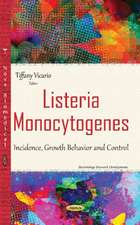Bacterial Activation of Type I Interferons
Editat de Dane Parkeren Limba Engleză Hardback – 15 oct 2014
Bacterial Activation of Type I Interferons reviews both the current understanding of how different bacterial species are able to activate this pathway as well as the influence type I IFNs have on the outcome to infection. Several different bacterial species are covered, spanning Gram positive and Gram negative, intracellular, extracellular, and different host infection sites. An introduction to the pathogenesis of each organism is provided, and the signaling molecules involved in the activation of the type I IFN pathway and the role it plays in animal infection models are also covered.
| Toate formatele și edițiile | Preț | Express |
|---|---|---|
| Paperback (1) | 632.70 lei 43-57 zile | |
| Springer International Publishing – 27 sep 2016 | 632.70 lei 43-57 zile | |
| Hardback (1) | 638.89 lei 43-57 zile | |
| Springer International Publishing – 15 oct 2014 | 638.89 lei 43-57 zile |
Preț: 638.89 lei
Preț vechi: 751.64 lei
-15% Nou
Puncte Express: 958
Preț estimativ în valută:
122.29€ • 132.88$ • 102.79£
122.29€ • 132.88$ • 102.79£
Carte tipărită la comandă
Livrare economică 21 aprilie-05 mai
Preluare comenzi: 021 569.72.76
Specificații
ISBN-13: 9783319094977
ISBN-10: 3319094971
Pagini: 129
Ilustrații: VII, 129 p. 12 illus., 10 illus. in color.
Dimensiuni: 155 x 235 x 17 mm
Greutate: 0.38 kg
Ediția:2014
Editura: Springer International Publishing
Colecția Springer
Locul publicării:Cham, Switzerland
ISBN-10: 3319094971
Pagini: 129
Ilustrații: VII, 129 p. 12 illus., 10 illus. in color.
Dimensiuni: 155 x 235 x 17 mm
Greutate: 0.38 kg
Ediția:2014
Editura: Springer International Publishing
Colecția Springer
Locul publicării:Cham, Switzerland
Public țintă
ResearchCuprins
Production and action of type I interferons in host defense.- Induction and consequences of the type I IFN response to Listeria monocytogenes.- Innate immune and type I IFN responses during Legionella pneumophila infection.- Type I interferons in immune defense against streptococci.- Activation of type I IFN signaling by Staphylococcus aureus.- Contribution of interferon signaling to host defense against Pseudomonas aeruginosa.- The detrimental role of type I interferon signaling during infection with Salmonella typhimurium.- Yersinia activation of type I interferon.- Induction and Function of Type I IFNs During Chlamydial Infection.- Regulation of Host Response to Mycobacteria by Type I Interferons.
Textul de pe ultima copertă
The type I interferon (IFN) signaling pathway is well recognized as a pathway activated by viral infections. It is activated by a variety of microbial pattern recognition receptors including the Toll-like receptors, NOD-like receptors and several cytosolic receptors. Activation of the type I IFN pathway leads to the production of both antiviral factors and products that influence immune cell function. More recently it has been shown that bacteria are also capable of activating this pathway.
Bacterial Activation of Type I Interferons reviews both the current understanding of how different bacterial species are able to activate this pathway as well as the influence type I IFNs have on the outcome to infection. Several different bacterial species are covered, spanning Gram positive and Gram negative, intracellular, extracellular, and different host infection sites. An introduction to the pathogenesis of each organism is provided, and the signaling molecules involved in the activation of the type I IFN pathway and the role it plays in animal infection models are also covered.
Bacterial Activation of Type I Interferons reviews both the current understanding of how different bacterial species are able to activate this pathway as well as the influence type I IFNs have on the outcome to infection. Several different bacterial species are covered, spanning Gram positive and Gram negative, intracellular, extracellular, and different host infection sites. An introduction to the pathogenesis of each organism is provided, and the signaling molecules involved in the activation of the type I IFN pathway and the role it plays in animal infection models are also covered.
Caracteristici
Study of the effect of Type I IFNs on the immune system, from beneficial to detrimental Focuses on the ability of certain bacterial components to activate the IFN I signaling pathways Discusses how pathogen-associated molecular patterns (PAMPs) are detected by toll-like receptors (TLRs) Includes supplementary material: sn.pub/extras











